Building visibility on Google isn’t just about backlinks or content — it’s about conversations, engagement, and authority across platforms. And that’s where X (formerly Twitter) quietly becomes a secret weapon. As Google’s AI Overviews reshape search results and the third-party cookie era ends, brands that harness social signals from X are seeing a measurable boost in their rankings.
Table of Contents
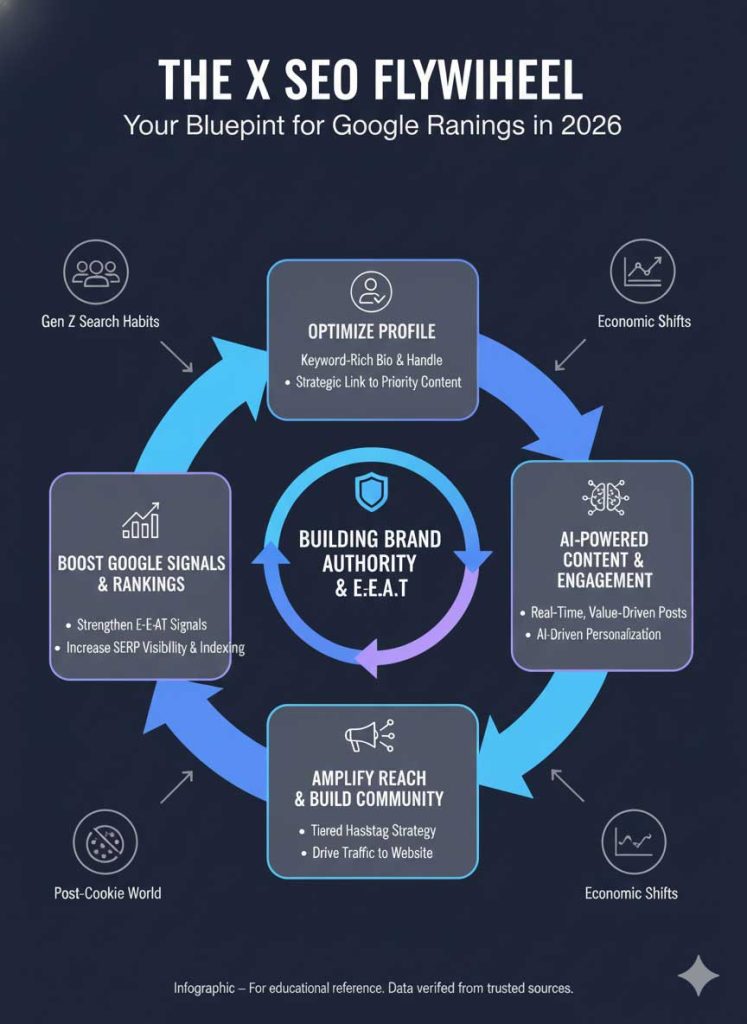
Yet, many marketers still treat X as a place for quick posts, not a core SEO tool — and that’s a costly oversight. This article delivers a comprehensive, data-driven framework to boost your brand’s Google rankings using X (formerly Twitter). We’ll move beyond surface-level tactics to explore advanced X SEO strategies for 2026, reveal how AI is transforming digital marketing, and show you how to master social search optimization to build topical authority and real growth in the competitive U.S. market.

The Paradigm Shift: Why X Is a Non-Negotiable SEO Tool in 2026
The very definition of “search” has been irrevocably altered. To win in this new era, marketers must look beyond their websites and embrace a “search everywhere” mentality. X is no longer just a platform for conversation; it’s a powerful engine for discovery, and Google is paying close attention.
Redefining “Search”: How Gen Z Treats Social Platforms as Primary Search Engines
The concept of social search optimization isn’t a future trend; it’s the current reality. A staggering 40% of Gen Z now uses platforms like TikTok and X as their primary search engines. They seek visual answers, real-time opinions, and authentic brand interactions, bypassing traditional search engines for many queries.
This behavioral shift has profound implications. If your brand isn’t optimized for discovery on X, you are effectively invisible to a massive and growing segment of the consumer market. A robust plan for brand visibility on X (formerly Twitter) is no longer optional.

E-E-A-T and Brand Authority: How Google Interprets Your X Presence
Google’s E-E-A-T (Experience, Expertise, Authoritativeness, and Trustworthiness) framework is the bedrock of its ranking algorithm. The algorithm assesses your brand’s credibility not just from your website but from signals across the entire web.
A consistently active, expert-level X profile sends powerful authority signals to Google. When you share insightful industry commentary, engage with other experts, and build a community around your niche, you are actively demonstrating your E-E-A-T. This reinforces your brand’s credibility and can positively influence your rankings.
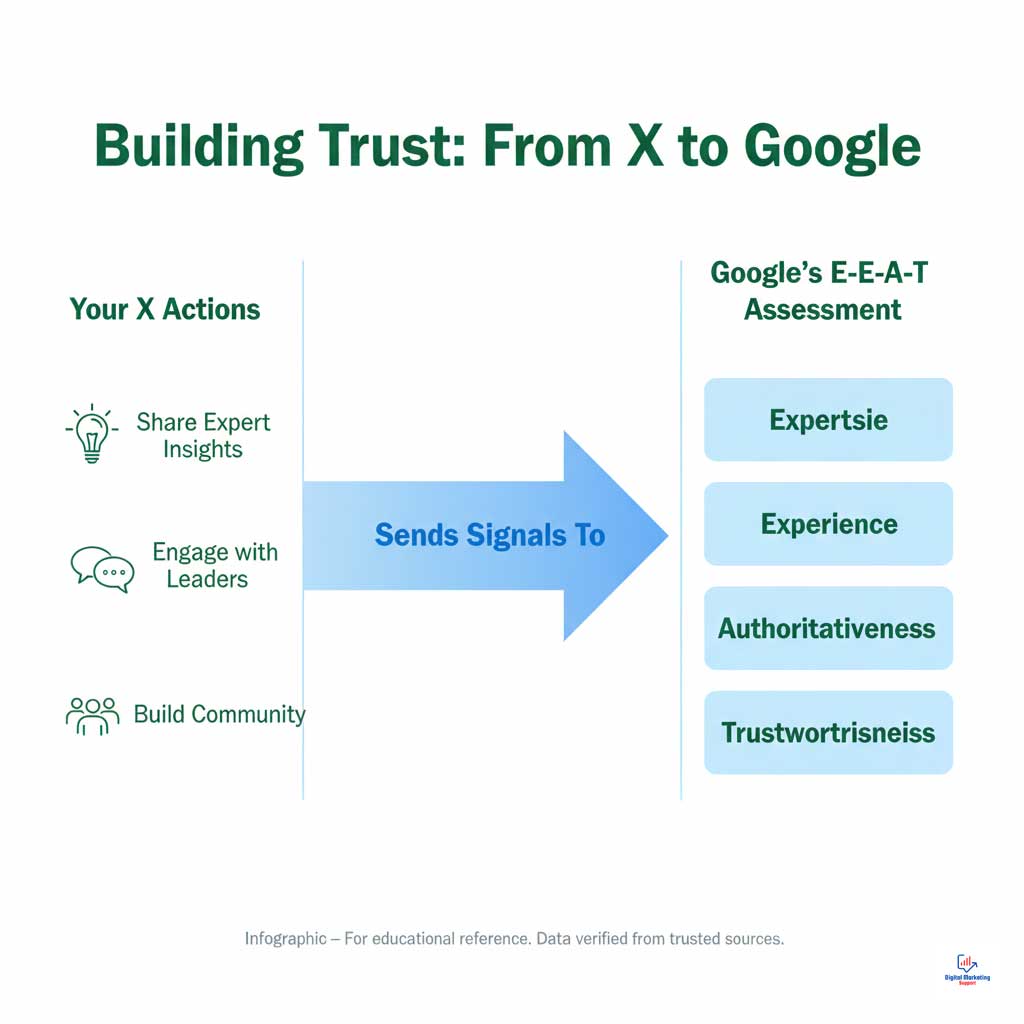
The Indexing Advantage: How Your Tweets Become SERP Real Estate
Here is a critical connection many marketers miss: Google directly indexes X profiles and individual tweets. When news breaks or a topic starts trending, Google’s SERPs often feature a real-time carousel of relevant tweets.
This means your content on X can become valuable SERP real estate, giving you another opportunity to appear on the first page. For branded searches, a brand’s official X profile and recent tweets frequently appear, offering a direct line of communication and brand management within Google’s own ecosystem. This is a core component of effective X (formerly Twitter) SEO strategies for 2026.
Foundational X SEO: Building a Profile That Ranks
Before you can implement advanced tactics, you must ensure your foundation is solid. Your X profile is your digital billboard, and every element must be optimized for discovery by both users and search engine crawlers.
Crafting a Keyword-Rich Bio, Handle, and Username
Your X bio is prime real estate for SEO. It should be a concise, compelling summary of your brand’s value proposition, naturally infused with your primary and secondary keywords.
- Handle (@YourBrand): Make it clean, memorable, and consistent with your branding across all platforms.
- Username (Display Name): You have more flexibility here. Consider adding a keyword-rich descriptor after your brand name (e.g., “Chime | Digital Banking”).
- Bio: Clearly state who you are, what you do, and who you serve. Weave in 2-3 core keywords that define your niche to improve discoverability.
The Strategic Power of Your Profile Link
The single link in your bio is an incredibly powerful tool for driving referral traffic—a key behavioral signal that Google monitors. Don’t just set it and forget it.
Use this link strategically to support your cross-channel campaign management efforts. Point it to your latest blog post, a new product landing page, a webinar sign-up form, or a curated hub of your most important links. An effective X content optimization for brands strategy includes regularly updating this link to align with current marketing objectives.
Visual SEO: Optimizing Images and Alt Text for Discovery
Visuals are not exempt from SEO. Optimizing your profile and header images can provide a subtle but meaningful boost.
- File Naming: Before uploading, rename your image files to include relevant keywords (e.g., brand-name-digital-marketing-header.jpg).
- Alt Text: Always add descriptive alt text to your images. This not only improves accessibility for visually impaired users but also gives search engines more context about your profile’s content.

AI in Digital Marketing: Supercharging Your X Content and Engagement
The integration of AI in digital marketing has moved from theoretical to practical, profoundly impacting social media workflows. AI empowers brands to scale their efforts, personalize communication, and extract deep insights from data, which is essential for competing in the current digital marketing trends USA.
AI-Driven Personalization for Hyper-Relevant Campaigns
Personalized marketing with AI is the antidote to content saturation. AI algorithms can analyze vast datasets of user behavior—likes, retweets, followed accounts, and conversational topics—to understand individual preferences.
This allows brands to move beyond broad demographic targeting and deliver hyper-relevant content that resonates on a one-to-one level. This level of personalization dramatically increases engagement rates and fosters stronger brand loyalty.
Leveraging Generative AI Tools like X Mind for High-Engagement Content
The scale of AI adoption is staggering; over 15 million AI-generated ads are created monthly across platforms like Meta, TikTok, and X. Tools specifically designed for X, such as the conceptual X Mind, are changing the game for content creation.
These generative AI tools can analyze trending conversations, identify high-performing content formats, and even draft tweet campaigns that align with your brand voice. This saves countless hours and leverages data to craft content with a higher probability of engagement, making it a cornerstone of modern data-driven social strategies.
Data-Driven Social Strategies: Using AI to Pinpoint the Best Time to Post
The age-old question, “When is the best time to post?” is finally getting a sophisticated answer. Generic industry benchmarks are becoming obsolete. AI-powered analytics tools provide a far more accurate solution.
By analyzing your specific audience’s activity patterns, these tools can identify the precise windows when your followers are most active and receptive to your content. This data-driven approach to scheduling maximizes reach and engagement, ensuring your content doesn’t get lost in the noise.
Strategic Comparison: Traditional SEO vs. X-Driven Social SEO
To fully grasp the opportunity, it’s essential to understand how social search optimization complements traditional SEO. They are not mutually exclusive; they are two sides of the same coin, working together to build comprehensive brand authority.
| Feature | Traditional Website SEO | X-Driven Social SEO |
| Primary Goal | Rank specific web pages for keywords. | Build brand authority and rank in real-time conversations. |
| Key Signals | Backlinks, on-page content, site speed. | Engagement (likes, replies), profile authority, real-time trends. |
| Content Velocity | Slower; focused on long-form, evergreen content. | High; focused on timely, concise, and conversational content. |
| Keyword Focus | High-volume, long-tail keywords. | Conversational, trending, and branded keywords/hashtags. |
| Time to Impact | Medium to long-term (months). | Short-term to immediate (minutes/hours for trends). |
| Audience | Users with explicit search intent on Google. | Users with passive and active discovery intent on X. |
Advanced Tactics for Cross-Channel Dominance and Brand Visibility
With a solid foundation and AI-powered insights, you can deploy advanced tactics to achieve true cross-channel dominance and maximize your brand visibility on X (formerly Twitter).
A Modern Hashtag Strategy for X SEO: Beyond Simple Tagging
An effective hashtag strategy for X SEO is about more than just tacking on popular tags. It requires a tiered, strategic approach to connect with the right conversations.
- Branded Hashtags (#YourBrandEvent): Use these to consolidate conversations around your campaigns and encourage user-generated content.
- Community Hashtags (#FintechFridays): Tap into niche communities by using hashtags that are well-known and respected within your industry.
- Trending Hashtags: Cautiously and authentically join larger, trending conversations where your brand can add genuine value.
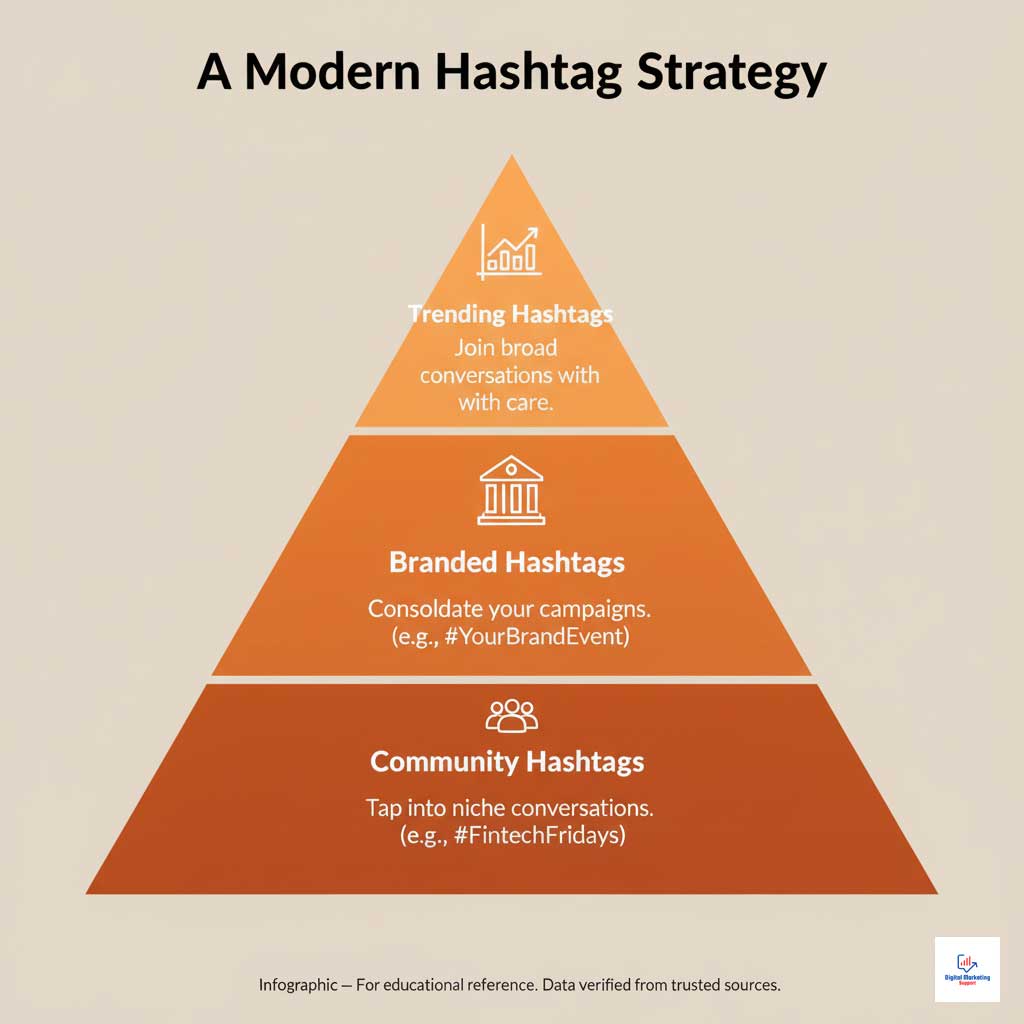
Real-Time Engagement Marketing: Turning Volatility into Visibility
X thrives on immediacy. The brands that win are those that can react in real time. The current financial news impact digital marketing landscape provides a perfect example, as market volatility often creates opportunities for timely commentary.
Effective real-time engagement marketing involves using social listening tools to monitor industry news, brand mentions, and competitor activity. When an opportunity arises, be ready to join the conversation with authentic, valuable insights—not just a sales pitch.
Cross-Channel Campaign Management: Making 1+1 = 3
Your X (formerly Twitter) SEO strategies for 2026 should not exist in a silo. True power is unlocked through effective cross-channel campaign management.
Use X to amplify your cornerstone content, like blog posts and whitepapers. Promote your webinars and podcasts to drive sign-ups. Share behind-the-scenes content from company events. This creates a powerful flywheel effect: X drives traffic and signals to your website, and your website provides deep, authoritative content to share on X.
Navigating the Economic and Privacy Landscape of 2026
External forces, from economic pressures to privacy regulations, are continually reshaping the digital marketing playbook. A resilient strategy must be adaptable to these changes.
Financial Market Trends Shaping Digital Marketing ROI
Recent economic shifts, including US tariffs and supply chain disruptions, have put immense pressure on marketing budgets. This has forced a re-evaluation of PPC and ad spending, leading many brands to double down on organic channels that deliver sustainable, long-term ROI.
An effective organic strategy, with a strong emphasis on social search optimization, becomes a more reliable and cost-effective engine for growth during times of economic uncertainty.
The Post-Cookie Imperative: Using X for First-Party Data Collection
The importance of first-party data post-cookie era cannot be overstated. With the deprecation of third-party cookies, data you collect directly from your audience is gold. X is an invaluable channel for this.
You can ethically collect first-party data by:
- Running X Polls to gather audience opinions and segment interests.
- Hosting interactive Q&As that encourage engagement and dialogue.
- Driving traffic to gated content on your website where users can exchange their contact information for a valuable resource.

Case Study Spotlight: Chime’s Growth and Fintech Marketing
The impressive growth of fintech companies like Chime signals a broader trend: a massive increase in digital marketing spend within the sector. In a crowded market built on trust, platforms like X are essential for building community, educating consumers, and establishing brand credibility—all key components of a strong SEO foundation. This is a real-world example of how to use X for SEO in the USA (2026).
The Tangible Impact: Real-World Results and a Practical Checklist
Theory is nothing without application. The brands that successfully integrate these strategies are seeing measurable results that go far beyond vanity metrics.
Case Study: Deconstructing the Pittsburgh Steelers’ X Campaigns
The Pittsburgh Steelers’ X presence is a masterclass in community engagement. By leveraging high-energy video highlights, fan-centric giveaways, and real-time game commentary, they foster immense brand loyalty and drive massive online conversation.
These efforts result in high brand visibility on X (formerly Twitter), which translates directly into dominant branded search results on Google. This is a prime example of real-world X SEO campaign results 2026 USA, showcasing how strong social engagement builds a powerful SEO moat.
Measuring Success: Key Metrics to Track for X SEO ROI
To prove the value of your efforts, focus on metrics that connect directly to business outcomes.
| Action Item | Priority | Description |
| Optimize X Profile Bio | High | Integrate primary keywords and a clear value proposition. |
| Set Up Keyword Monitoring | High | Use social listening tools to track brand and industry keywords. |
| Develop a Content Calendar | High | Plan a mix of promotional, educational, and engagement-focused content. |
| Integrate AI Content Tools | Medium | Test AI tools for drafting tweets and analyzing performance data. |
| Run a Hashtag Audit | Medium | Analyze the performance of current hashtags and research new opportunities. |
| Establish a First-Party Data Plan | Medium | Create a strategy to use X to drive newsletter sign-ups or gated content. |
| Analyze Competitor X Strategy | Low | Periodically review what competitors are doing successfully on the platform. |
| Track Referral Traffic in GA | Ongoing | Monitor how much traffic X is sending to your website and which pages. |
Summary & Key Takeaways: Your Roadmap to X SEO Success in 2026
The lines between social media and search have officially blurred. X is an indispensable tool for modern SEO, a dynamic platform for demonstrating authority, engaging with customers in real time, and driving meaningful traffic.
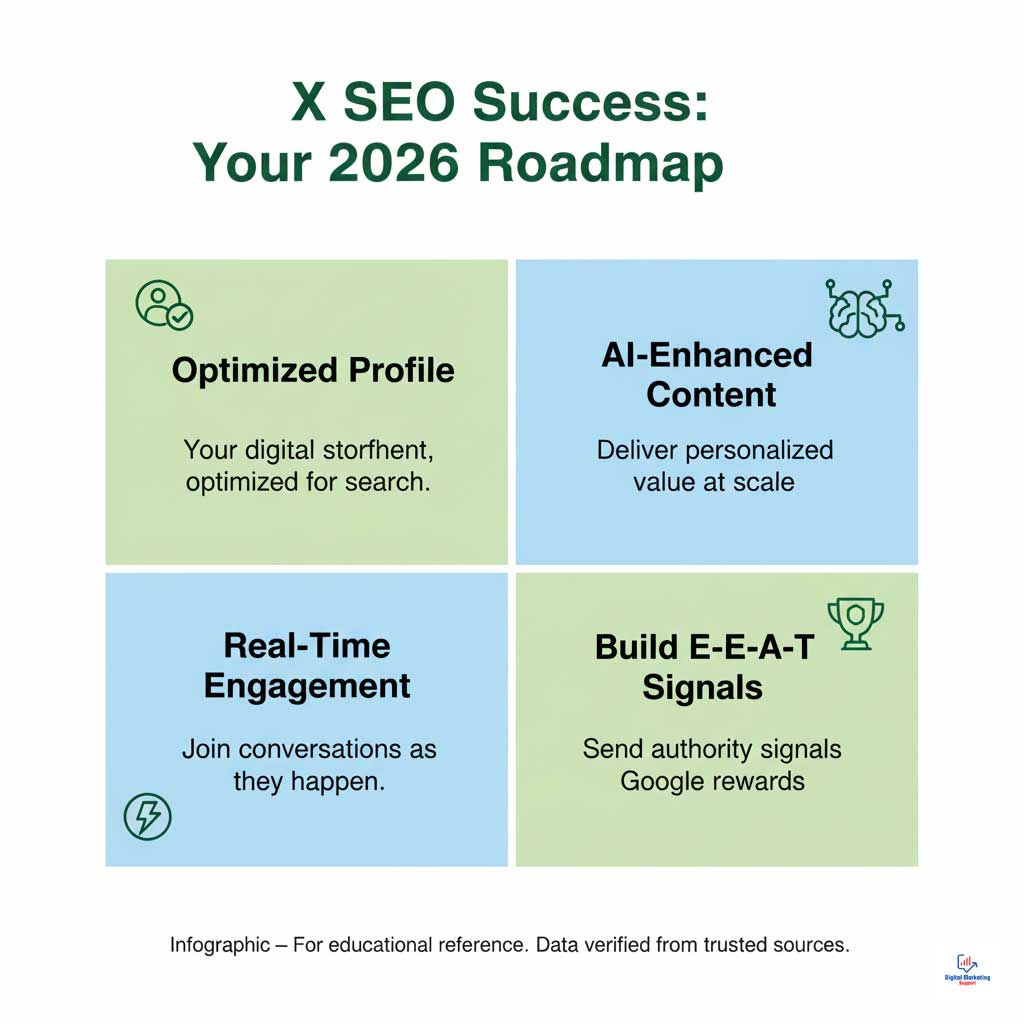
Success hinges on a multi-faceted approach built on key pillars: a fully optimized profile that acts as your digital storefront, an AI-enhanced content strategy that delivers personalized value at scale, a commitment to real-time engagement marketing, and a relentless focus on building E-E-A-T signals that Google will reward. By implementing these advanced X (formerly Twitter) SEO strategies for 2026, your brand can not only survive but thrive in Google’s evolving search landscape, capturing new audiences and building lasting authority.
Frequently Asked Questions (FAQs)
Is X (formerly Twitter) still relevant for SEO in 2026?
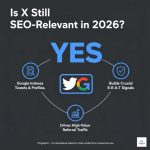
Yes, X is highly relevant. Google indexes X profiles and tweets, using the platform’s real-time engagement and authority signals to inform search rankings, especially for timely topics and branded queries.
What are the best X SEO tactics for US brands?

Focus on optimizing your profile with local or industry keywords, engaging with US-based trends and audiences, understanding the search habits of Gen Z, and aligning your content with the cultural and economic landscape of the USA.
How does AI impact digital marketing strategies on social platforms?

AI supercharges social strategies by enabling hyper-personalization, automating content creation for high-engagement campaigns, and providing deep analytics to optimize posting times and content formats for maximum impact.
How do I get my brand’s tweets to show up on Google?
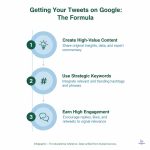
Increase your chances by creating high-value content, using relevant and trending hashtags, earning high engagement (likes, replies), and participating in authoritative conversations within your niche.
What are “social signals” and do they affect SEO?

Social signals are metrics like likes, shares, and follower counts. While they are not direct ranking factors, they contribute indirectly by increasing brand visibility, driving website traffic, and encouraging natural backlinks, all of which are valued by Google.
How can I use X to collect first-party data?

Use X to promote gated content (like ebooks or webinars), run polls to gather audience insights, and drive traffic to your website where users can sign up for newsletters, creating a direct line of communication in the post-cookie era.
What financial shifts must digital marketers consider for 2026?

Marketers must be agile in response to inflation, supply chain costs, and market volatility. This means prioritizing organic strategies like X SEO that offer sustainable ROI and being prepared to pivot ad spend based on real-time economic news.
How do I measure the SEO ROI from my X activities?

Track key metrics like referral traffic from X in Google Analytics, growth in branded search volume in Google Search Console, and the number of leads or sales that can be attributed to your X campaigns via UTM parameters.
Should I use AI to write all my tweets?

It’s best to use AI as a co-pilot. Use it to generate ideas, analyze data, and draft initial content, but always add a human touch to ensure authenticity, brand voice, and genuine engagement.
What’s the difference between social search and traditional search?
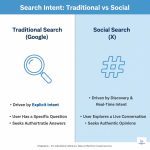
Traditional search (on Google) is typically driven by explicit intent—a user has a specific question. Social search (on X) is often driven by discovery and real-time intent—a user is exploring a topic, trend, or conversation as it happens.
How long does it take to see SEO results from X?
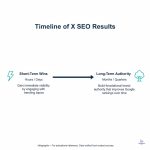
You can see short-term visibility boosts within hours by engaging with a trending topic. However, building foundational brand authority and seeing a consistent impact on your Google rankings is a long-term strategy that takes several months of consistent effort.
Can a hashtag strategy really improve my Google rankings?

Indirectly, yes. A strong hashtag strategy expands your content’s reach on X, leading to higher engagement, more profile views, and increased brand mentions. These activities build your brand’s overall authority, which is a positive signal for Google.








